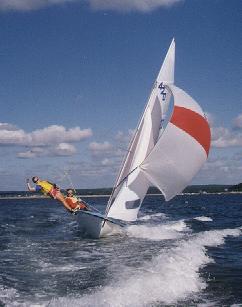Reading about accidents may give the impression that boating is a particularly dangerous sport, but remember that safe days on the water usually are not reported in the press.

On June 23, 2011 near the mouth of the Severn River in Annapolis, Maryland a series of otherwise minor events conspired to lead to a small boat capsize that claimed the life of a young sailor. The boat was a Club 420 one-design, a 13’9,” 240 lb. sailing racing dinghy, crewed by two teenage women. The 420 “has been the standard North American class for sailors between the ages of about 12 and 21, [and it’s] used in many intercollegiate sailing and yacht club junior programs.” Experienced 420 sailors use a trapeze and spinnaker. The two young women aboard were members of the Severn Sailing Association (SSA) sponsored Chesapeake Racers Club 420 travel team. In prior years both sailors had been had been trained to right capsized Optimist dinghies, and the crewmember had been trained to right 420s without trapeze equipment. The righting of intentionally capsized one-designs is a routine practice exercise. The boat crews were wearing U.S. Coast Guard-approved Type III vest-type lifejackets. The wind at the time was 5-10kn, with gusts to 12kn and shifting.
The 420s were practicing spinnaker and trapeze work this day, under the supervision of instructors operating nearby from motorized boats. On the young women’s sailboat “the spinnaker was about half-way down and the wind shifted, accidentally jibing the boat. The boom swung across the cockpit, pressing the crewmember outboard and forward. [The skipper] heard her crew woman say, ‘I’m stuck on something.’ There was no indication of distress.” The boat went far over on its side, and “continued to roll until the mainsail was in the water. [The skipper] expected that her crew would swim out from behind the mainsail, as she had been trained to do . . . “ but she did not. The young sailor was discovered under the boat, floating in a vertical position, entangled in the trapeze, apparently unconscious. A nearby coach immediately approached the boat, radioed for additional assistance, and worked diligently to free the victim. Concurrently, another instructor phoned 911. Once the trapped sailor was retrieved from the water, other coaches immediately performed CPR and proceeded to the U.S. Naval Academy's seawall, which was the nearest point of land, to meet the emergency response team. Unfortunately, [she] could not be resuscitated.”
On July 6, 2011, the Severn Sailing Association held a meeting in Annapolis with the United States Sailing Association to discuss the incident with its officers and staff, to help everyone determine what might be done to prevent another such tragedy. The accident was thoroughly reviewed by a panel of experts and a report issued on October 22, 2011. Some of the findings:
- Several small events, precipitated by the accidental jibe, contributed to the accident, none of which were the singular cause of the fatal accident.
- Both sailors wore approved lifejackets. The young sailor would have floated up into the air pocket under the boat had she not been entangled in the trapeze.
- The conditions were not excessive for the boat or crew. They had sailed the boat earlier in the week in more wind and were ready to practice with the spinnaker and trapeze.
- The sailors were supervised by an experienced professional coach who arrived at the capsized boat very quickly. Other coaches were in nearby motorboats and assisted with CPR, radio and cell phone calls.
- The coaches on the water and the people on shore effectively implemented the improvised emergency plans.
- Less than three hours after the accident, the Severn Sailing Association arranged for psychiatric counseling sessions for family members, instructors, and other sailors. They recognized the possibility for PTSD. The report praises the SSA for its actions.
- Research the strengths and weaknesses of various types of lifejackets for dinghy sailing.
- Research and make recommendations for methods of dealing with capsized boats and entrapped sailors. Teach the methods that work in sailing programs.
- Test the relative effectiveness of emergency communications using VHF, cell phones, social media, personal locator beacons (PLBs), SPOT personal satellite messengers, whistles, flares and emergency lights.
- Develop templates for risk management procedures and incident/disaster plans for use by sailing programs, yacht clubs and race organizers.
- Develop a standard verbal and non-verbal vocabulary and grammar for emergency communication. [See the entries for Mayday, Pan Pan, and prowords in the Mariner’s Guide ]
- The Maryland Department of Natural Resources said that the young woman’s death was the result of drowning, not head injury or trauma. “Like many drownings, this one occurred extremely rapidly.”
For the complete 24-page PDF, Inquiry into the Sailing Accident at Annapolis, Maryland, June 23, 2011 see http://about.ussailing.org/US_SAILING_Meetings/USS_Reports.htm. There are many instructive details. [The quotations above are from this report.] The photo of the Club 420 is from website of the Buzzards Sailing School, www.buzzardssailing.org.
 RSS Feed
RSS Feed